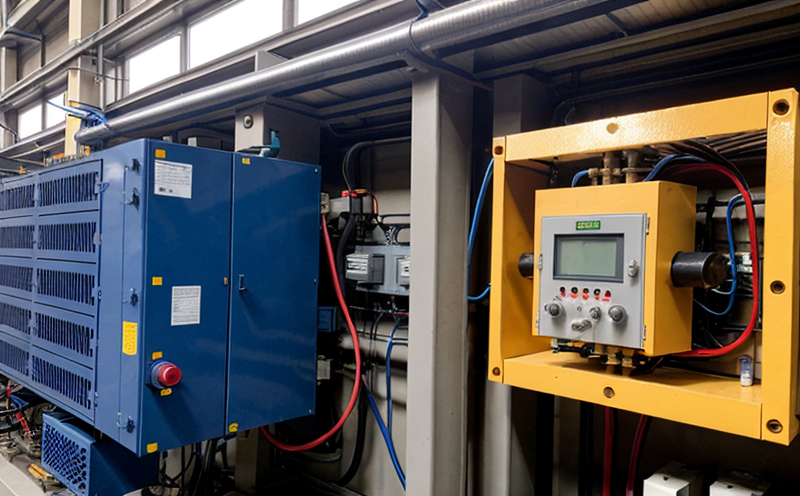Control relay inspection
In the realm of electrical and electronic systems inspection, control relays play a crucial role in ensuring reliable operation. A control relay is an electrically operated switch that responds to a small current from a controller to switch another device controlled by the relay on or off. The integrity and performance of these devices are paramount for safety, efficiency, and reliability in various sectors including automotive, aerospace, industrial automation, and telecommunications.
The primary goal of control relay inspection is to ensure that relays operate as intended under specified conditions. This involves a series of tests aimed at verifying the mechanical, electrical, and performance characteristics of these components. Testing methods are based on international standards such as IEC 61131-2 for programmable logic controllers (PLCs) and EN 61865 for relay protection systems.
Control relay inspection typically includes visual inspections to check the physical integrity, cleanliness, and appearance of the relay. Electrical tests are performed to verify the continuity of contacts, resistance between terminals, and the presence or absence of short circuits and open circuits. Additionally, functional testing assesses how well the relay responds to input signals, ensuring that it operates correctly under various conditions.
Before performing any inspection, proper specimen preparation is essential. This involves cleaning the relay with appropriate solvents and ensuring all connections are free from dirt or debris. Once prepared, the relay undergoes a series of tests using specialized equipment capable of simulating real-world operating environments. The results of these tests are documented thoroughly to provide comprehensive reporting that meets regulatory requirements.
Understanding the importance of control relay inspection in different sectors helps appreciate its significance. For instance, in automotive applications, reliable relays ensure proper functioning of safety systems like airbags and anti-lock braking systems. In industrial settings, accurate relaying ensures consistent production processes by controlling critical machinery components. These examples underscore why maintaining high standards for control relay inspections is non-negotiable.
| Application | Type of Control Relay | Purpose |
|---|---|---|
| Automotive Safety Systems | Time Delay Relays | To ensure timely activation and deactivation of safety features. |
| Industrial Automation | Magnetic Latching Relays | To maintain the state of a circuit even after power is removed. |
The precision and reliability demanded by modern industries make detailed inspection procedures necessary. By adhering to stringent protocols, manufacturers can ensure their products meet rigorous quality standards set forth by relevant authorities.
| Test Parameters | Description |
|---|---|
| Continuity Test | Checks if there is an uninterrupted electrical path between terminals. |
| Resistance Measurement | Determines the amount of resistance present in the relay circuitry. |
| Load Testing | Simulates actual load conditions to assess performance under stress. |
The data collected during these inspections form the basis for detailed reports which not only document test results but also provide recommendations for improvements where necessary. These comprehensive analyses help ensure that each relay meets stringent quality benchmarks, thereby enhancing overall system reliability.
Industry Applications
Control relays find extensive application across diverse industries due to their versatility and reliability. In automotive manufacturing, they are integral in managing complex electronic systems that ensure vehicle safety features operate seamlessly. For example, time delay relays play a vital role in activating airbags only when necessary, thereby enhancing passenger protection.
- Automotive Safety
- Industrial Automation
- Aerospace Systems
- Telecommunications Infrastructure
In industrial automation, magnetic latching relays are used extensively to maintain circuit states even after power is cut off. This ensures smooth transition between different operational modes without interruption.
| Sector | Relay Type | Main Function |
|---|---|---|
| Aerospace Systems | Thermal Relays | To protect sensitive components from overheating and damage. |
| Telecommunications Infrastructure | Microprocessor Controlled Relays | To manage complex network configurations efficiently. |
The choice of appropriate relay type depends on specific requirements like operating voltage, current handling capability, and environmental conditions. Proper selection ensures optimal performance tailored to each application domain.
Eurolab Advantages
At Eurolab, our commitment to excellence in control relay inspection sets us apart from other laboratories. With state-of-the-art facilities and experienced technicians, we offer unmatched accuracy and consistency in test results.
- ISO 17025 Accreditation
- International Standard Compliance
- Expert Technicians with Extensive Experience
- Comprehensive Reporting Capabilities
We employ advanced testing equipment capable of simulating real-world conditions, ensuring reliable and repeatable results. Our multi-disciplinary team combines expertise in electrical engineering, materials science, and quality assurance to deliver robust solutions.
The use of international standards such as IEC 61131-2 for PLCs and EN 61865 for relay protection systems guarantees that our inspections meet the highest industry expectations. By adhering strictly to these guidelines, we ensure consistent quality across all projects.
Why Choose This Test
Selecting control relay inspection as part of your quality assurance process offers numerous advantages. Here are some compelling reasons:
- Enhanced Reliability: Ensures that relays function correctly under various operational conditions, reducing the risk of failures.
- Compliance Assurance: Meets regulatory requirements and industry standards, ensuring compliance with international norms.
- Improved Safety: Critical in sectors where safety is paramount, such as automotive and aerospace industries.
- Precision & Consistency: High-precision testing ensures consistent performance across all units produced.
- Cost Efficiency: Early detection of potential issues prevents costly repairs or replacements later on.
- Detailed Reporting: Comprehensive reports provide valuable insights into the current state and future needs of your systems.
By investing in control relay inspections, you not only safeguard against operational disruptions but also contribute to a safer work environment. Our detailed testing procedures and rigorous reporting ensure that every aspect of the relays' performance is thoroughly evaluated.





